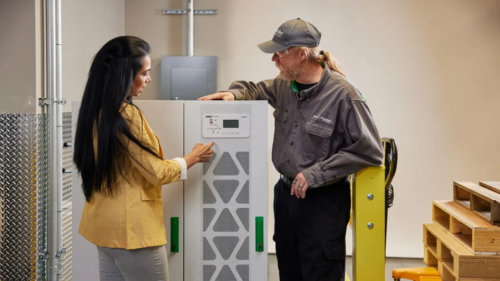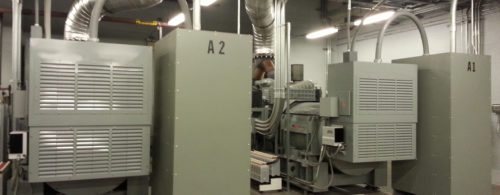Using natural gas for temporary power
A clean, cost-effective power solution is needed to provide additional power support to energy companies, municipalities, and federal agencies.
In its recent “World Energy Outlook,” the International Energy Agency (IEA) forecasted the global structural imbalance for electricity to grow from 50 GW per annum to around 600 GW by 2015. A majority of this unmet demand will occur in emerging markets, where local power resources and transmission infrastructure can be limited or unreliable. Against this background, the capabilities of large-scale temporary power technology are compelling. With rapid installation and commissioning, mobile generating systems can provide power within weeks, not years. The upfront capital requirement is low relative to permanent power plants, and they can support a variety of industrial and civil needs: from supplying emergency power generation in the aftermath of natural disasters to providing grid stability and support for periods when current power facilities are undergoing maintenance or are being replaced or upgraded. Mobile power generation can also be distributed across the grid, eliminating or reducing the need for additional transmission infrastructure. Then, when permanent capacity is able to meet demand, units can be relocated to other areas of need.
In the U.S., where power outages occur less frequently and industrial production runs smoothly 24/7, uninterrupted power is taken for granted, and temporary power generation is usually thought of as a backup or an emergency power source in the rare case that the electricity supply goes down (see Figure 1). However, there are three significant factors that will accelerate the domestic need for temporary power generation: an aging power infrastructure, climate change, and a domestic natural gas production boom that is most likely to take place in remote areas off the electrical grid.
Aging American infrastructure
The U.S. electrical grid is a complex network of independently owned and operated power plants and transmission lines. If the U.S. is to remain competitive and serve increased energy needs of its growing population, a significant investment is needed in infrastructure and new power plants in the coming decades. In the most recent “Report Card for American Infrastructure” published by The American Society of Civil Engineers, the nation’s electrical grid was described as a patchwork system that ultimately will break down unless $673 billion is invested in it by 2020. If investment isn’t increased by at least $11 billion a year, the report said, the electrical service interruptions between now and 2020 will cost $197 billion.
The average age of U.S. power transformers in service is 40 years, which also happens to be the average life span of this equipment, and about 530 GW, or 51% of all generating capacity, comes from power plants that were at least 30 years old at the end of 2010, according to the U.S. Energy Information Administration website. Currently, 10 U.S. nuclear power plants have outlived their original 40-year permits and preliminary life expectancy predictions. Renewable energy sources such as wind and solar inevitably require standby capacity for downtimes, and therefore growth in the use of renewable energy sources is also expected to lead to further growth in demand for temporary power solutions.
Given the environmental and safety concerns associated with an aging power infrastructure, both developed and developing countries will increasingly be required to plan and finance extensive renovations to meet growing demand and enable sustainable economic growth. As such, a cleaner, more cost-effective power solution is needed to provide energy companies, municipalities, and federal agencies with additional power support for periods when current power facilities are undergoing maintenance, being replaced, or being upgraded to newer, more efficient technologies.
Climate impact on U.S. electrical grid
In 2011, The U.S. Global Change Research Program, which coordinates and integrates federal research on changes in the global environment and their implications for society, released a study on the impact of climate change on energy production and use in the U.S. The findings demonstrated how changes in temperature, precipitation, sea level, and the frequency and severity of extreme events will affect how energy is produced, delivered, and consumed in the domestic market.
With the planet surface temperature predicted to rise between 2 and 11.5 F by the year 2100, hotter than normal temperatures and increased drought periods will drive electricity consumption in affected areas, particularly in the Southeast and Southwest. Based on a 6.3 to 9 F temperature increase, climate change could increase the need for additional electric generating capacity by roughly 10% to 20% by 2050. At the same time, as the world’s fourth largest producer of hydroelectric power, the U.S. will face generational limits to its hydroelectric capacity due to droughts, increased agricultural use of water, and certain ecological considerations. Until then, additional capacity is funded and built. However, seasonal surges and temporary blackouts due to weather and climate-related events will make the U.S. increasingly reliant on rapidly mobilized temporary power generation.
Rising sea levels, changes in the frequency and severity of storms, and other extreme events may also impact the U.S. energy infrastructure, a large portion of which is located in coastal areas and therefore sensitive to sea level rise and storm surges. As witnessed during recent Category 4+ hurricanes, flooding and intense storms can damage power lines and electrical distribution equipment, while oil and gas pipeline disruptions following extreme weather events are often caused by power outages rather than physical damage to the infrastructure.
Domestic natural gas production boom
With the world production of unconventional gas (shale gas, tight gas, and coal bed methane) expected to more than triple between 2010 and 2035 to 1.6 trillion cubic meters, and the global gas demand forecast to rise by more than 50% between 2010 and 2035, the U.S. is poised to becomes a significant player in international gas markets. The American Gas Association estimates that the national inventory of gas reserves is approximately 300 trillion cubic feet, providing an on-the-shelf inventory of as much as a 100-year natural gas supply (see Figure 2). Such a transformation from a nation that depends largely on foreign oil to one capable of producing a surplus of clean natural gas is quite remarkable, and is a function of greater investment in domestic drilling and new technologies.
About a decade ago, innovators aggressively began to combine horizontal drilling, which allows producers to access large swaths of an underground resource from a single well, with hydraulic fracturing, or fracking, which uses high-pressure fluids to crack dense rock and allow oil and gas to flow. The combination has unlocked vast quantities of unconventional gas buried in shale rock deep underground. New technology breakthroughs are expected to make fracking more efficient in the future, while requiring less water and having less of an environmental impact. This is significant, as natural gas is expected to serve as a cleaner transition away from traditional fossil energy for power generation and transportation fuel. From a 50% share of the U.S. electric power market five years ago, coal supplied just 42% in 2011, and it is now below 40% in 2012. A rise in natural gas use, on the other hand, from 20% to near 30% at our electric utilities, is making up most of the difference (see Figure 3).
Benefits of natural-gas-fired temporary power
Clearly, the demand for reliable, large-scale temporary power capacity in the U.S is multifactorial and will continue to grow. As it does, energy companies, municipalities, and federal agencies will need ready access to sustainable, reliable, and more cost-effective generator technology. Like other developed nations, the U.S. depends on uninterrupted power for economic and social stability, and, compared to large-scale high-capacity reciprocating diesel generators, natural-gas-powered generation offers a number of advantages.
consequently, less downtime. In fact, a standard V-16, four-stroke-cycle engine running on natural gas needs fuel oil and filter changes every 1,000 service hr compared to the same engine running on diesel, which requires fuel oil and filters changed every 400 to 500 service hr. At an average cost of $1,800 per oil/filter change, this cost differential quickly adds up.
Gas engine deployment
Natural-gas-fired generators can be deployed similarly to diesel-fired generators, but a natural gas engine is capable of operating with a much broader fuel range, and with proper regulation on most pipeline gas systems. In challenging operating conditions, such as those at a drilling or mining site, diesel fuel can easily become contaminated with water, distillation residue, or particulate matter that will clog filters and contribute to fuel-pump failure. A natural-gas-fired generator, on the other hand, can run efficiently on a number of different grades of natural gas, including site gas, without significant mechanical issues. For permanent operations, natural gas fuel availability is now considered a prerequisite to site industrialization by a number of engineering and consulting firms.
Conclusion
The U.S. imports approximately 60% of the oil it consumes at a current rate of $1 billion per day, and the price of oil will likely continue to rise given the increased demand from rapidly developing countries in Asia, the Middle East, and South America. Natural gas provides an affordable, environmentally friendly substitute for both foreign oil and domestic coal, while stimulating America’s economy and strengthening its energy security. Looking ahead, as the demands placed on the U.S. power grid continue to challenge its capacity, natural gas should provide a long-term, reliable, and cost-effective alternative for both permanent and temporary power.
Wood is director of business development at APR Energy in Jacksonville, Fla. He has more than 30 years of experience in the power generation industry leading project management, sales, and business development teams. Campion is director of research and development at APR Energy. He has more than 25 years of experience in international and domestic power generation industries with emphasis on modularized power generation. He also has extensive experience overseeing new product design and prototyping for the temporary power industry.
Do you have experience and expertise with the topics mentioned in this content? You should consider contributing to our CFE Media editorial team and getting the recognition you and your company deserve. Click here to start this process.




